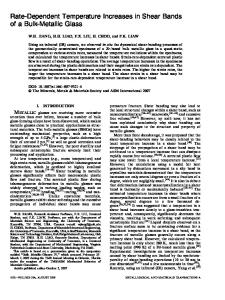In-Situ Observations of Shear Band Development during Deformation of a Bulk Metallic Glass
- PDF / 380,203 Bytes
- 6 Pages / 612 x 792 pts (letter) Page_size
- 81 Downloads / 353 Views
In-Situ Observations of Shear Band Development during Deformation of a Bulk Metallic Glass Paul A. El-Deiry1, Richard P. Vinci1, Nicholas Barbosa III1, and T. C. Hufnagel2 1 Department of Materials Science and Engineering, Lehigh University, Bethlehem, PA 18015, U.S.A. 2 Department of Materials Science and Engineering, Johns Hopkins University, Baltimore, MD 21218, U.S.A. ABSTRACT We have studied the development of shear band structure in a Zr57Ti5Cu20Ni8Al10 bulk metallic glass during deformation. In order to investigate the relationship between shear band development and serrated flow, we performed uniaxial compression tests in an environmental scanning electron microscope (ESEM). During the deformation, load-time data and surface images were simultaneously recorded. In the stress-time data, stress drops or “serrated flow” appear to correlate to new shear band formation. The majority of the shear bands we observed were at an angle of 45° with respect to the compression axis. In addition, we measured shear offset as a function of position along the shear band. We observed two different offset behaviors: Consistent offset along the length of a shear band, and offset that is localized into part of the band. The localized offset behavior could be evidence for dislocation-like displacement increments, or could be the result of a transition in the failure mode.
INTRODUCTION It is well known that low temperature plastic deformation in metallic glasses is concentrated into narrow regions called shear bands. In certain geometries, such as uniaxial tension, the resulting deformation is unstable and brittle failure follows shortly after the onset of yielding. In other geometries, such as bending and uniaxial compression, multiple shear bands can form. This results in behavior that is apparently “elastic-perfectly plastic.” One feature of interest observed in stress-strain curves from quasistatic uniaxial compression tests is the presence of "serrated flow" in the plastic regime. Despite extensive study [1-4], shear bands in bulk metallic glasses are not well understood. In particular, the details of how shear band formation and propagation determine the observed mechanical behavior are unknown. It is also not known whether slip along a shear band is best modeled as a sliding contact between two rigid surfaces or as the propagation of discrete displacement increments (i.e. dislocation-like). Once these details are fully understood, it will be possible to improve predictive models of plasticity in bulk metallic glasses and to suggest chemical or microstructural modifications to improve mechanical behavior. Our goal is to better characterize how and when shear bands form, as well as to determine the nature of displacement along a shear band. We can document shear band behavior by observing surface offsets that develop because of the formation and propagation of shear bands below the sample surface. Two key points are the relationship between stress-strain curves and shear band development, and the character of slip offset as a
Data Loading...











